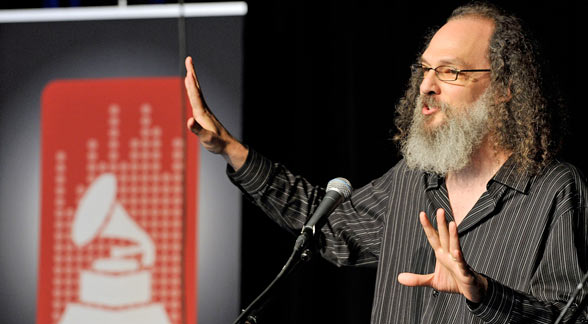Lost In Translation Redux
I spent the last 4 days in Manhattan, the lower side to be specific (airBnB worked wonderfully!) attending the CEA Audio Board meeting on Monday and a presentation by a couple of Grammy-winning engineers. The first hour was presented by two-time Grammy-winner Andrew Scheps (Adele, Red Hot Chili Peppers, Jay-Z and more) called “Lost In Translation”. 7-time Grammy-winner Elliot Scheiner, famous for his work with the Eagles and Steely Dan, presented the second half of the 2-hour session. Tom Fleishmann, an award-winning film mixer, joined Elliot. Their joint presentation focused on the recent documentary about the history of the Eagles.
I had heard about Andrew Scheps lecture/demonstration through my association with the NARAS organization (the Grammy folks). He’s been putting this particular show on around the country in association with the local chapters of the NARAS organization. And everything I’ve heard was encouraging.
Like many of his colleagues, Andrew has been experiencing the gradual degradation of audio fidelity after it leaves his capable hands/ears in the mixing studio. He mentioned that his daughter was complaining about being very fatigued after several hours of listening to her portable music player…issuing forth AAC files at 128/256 kbps (the Apple iTunes spec). So he decided to put together the “Lost In Translation” road show. I think he’s done it a half a dozen times. And it was very interesting.
The first thing that he did was describe the experience of music as it has evolved over the past couple of thousand years. Then he focused in on the recording of the song in mono, then stereo…then the development of multichannel technologies, mastering. He finished off with a description of the encoding process. What happens to the fully mastered as it makes its way to the various distribution channels…including iTunes, Spotify, YouTube etc. He laid out the technical specifications of each of these online retail stores and even touched briefly on higher sampling rates and longer word sizes. He did not mention DSD or SA-CD during his presentation. That format is simply not used in commercial recording studios.
Andrew said at his podium clicking through his presentation. There were illustrations about what happens during the compression and some charts with various formats. But the most interesting to me was the results of rigorous survey the Harman Kardon folks had done some years ago. They wanted to know if young people couple tell the difference between a 128 kbps AAC or MP3 audio file and the same track delivered as a CD “Redbook” standard recording. This was a strict test…with double blind procedures in place (A|B|X). The participants were of college age and some were even music or recording arts majors. All told, they evaluated 58 participants and 70% of them could tell the difference AND preferred the “high resolution”. That’s certainly encouraging, if gleaned from a rather small sample.
Genelec, a speaker manufacturer, provided a complete 5.1 home theater set up in the downstairs space of a restaurant not far from the CE Week exhibition hall. The core of Andrew’s lecture was the actual demonstration of the various formats that he had skillfully defined previously. He played a track straight from YouTube (which delivers a WHOLE lot of music content) at 128 kbps (sometimes they do better if there is HD-Video along with the music) through the Genelecs. He played the music straight from his Mac Book Pro using the onboard DAC but through an audio player called Decibel (it changes the sample rate buy detecting the metadata in the header of file, which sped things along).
The first comparison was “Strawberry Fields Forever” from the Sergeant Peppers Lonely Hearts Club Band album from 1967. Andrew played a portion of the song from YouTube (128 kbps) and then switched to a file at 44.1 kHz/24-bits. I was fortunate to have a good seat near the middle of the second row. It was very clear that the 44.1/24-bit file was superior. It was “better sounding” than the ogg vorbis file from YT.
But here’s where I have to chime in with a whole “provenance” thing. This track was recorded on a Studer 4 track machine in the 60s. (I actually have a copy of the multitrack masters in digital form for a few of the tunes!). The CD, the vinyl version and even the 48/24-bit HD version all sound great, given the constraints and aesthetics of the time. But I would love to rework the “Lost In Translation” presentation using real HD-Audio selections. Maybe I will…
Stand by…I’ll continue this thought.

